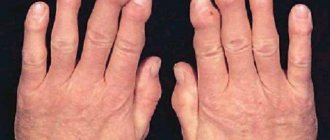Average reading time: 8 minutes
Publication date: August 09, 2021
Zakharova Carolina Yurievna
Physician and author of scientific articles on therapy, ophthalmology, pediatrics and psychiatry
The mark “37” on the thermometer can cause many questions. Should I be worried or is this normal? Or maybe it’s time to take antipyretics? Let's figure out what causes a slight fever and what should be done.
Up to contents
Why does the temperature rise to 37 °C?
Body temperature is not a constant value, it fluctuates during the day within the range of 0.1 -0.6 ° C, in the morning it is usually lower than in the evening1. Therefore, the norm may be within 36-37 °C1.
However, the method of measurement must be taken into account. Typically, body temperature is determined in the armpit, and here its optimal value is considered to be 36.6 °C1. And if you use a rectal thermometer and measure body temperature in the rectum, remember that here it is normally 0.5-1.0 °C higher than under the armpit1.
When the thermometer records a temperature between 37°C and 38°C (when measured in the armpit), this is already a fever1, but since it is not pronounced, it is called subfebrile3.
The term “subfebrile” comes from the words sub – “under, to a weak degree” and febris – “fever”3. Low-grade fever that lasts a long time is called low-grade fever3.
Depending on the severity, subfebrile condition is distinguished2:
- ● low – up to 37.1 °C;
- ● high – up to 38.0 °С2.
Despite the variety of causes, in 70-75% of cases, an increase in temperature to 37-38 ° C is caused by infection2. Infectious agents, such as viruses and bacteria, act as pyrogens4 - substances that rearrange the functioning of the thermoregulation center in the brain (hypothalamus). In this center, two areas are separately distinguished: heat production and heat transfer1,4. Under the influence of pyrogens, the balance of heat production and heat loss is disrupted, which leads to fever1,4.
Up to contents
Why might a teenager have it?
An increase in body temperature in adolescence is mainly associated with hormonal changes occurring in the child’s body. For example, in girls, the temperature may rise during the growth of the mammary glands, before menstruation, which is just beginning to become systematic. Sex hormones also provoke an increase in body temperature without symptoms in adolescents.
It is worth noting that it is during adolescence that an increase in body temperature can be a peculiar reaction to stress, tension, emotional and physical overload. Teenagers who are actively involved in sports report fatigue, headaches and hot flashes at certain moments. Low-grade fever in adolescents should not be perceived as a pathology - this is a natural reaction of the body to stress, but with the equalization of hormonal levels it will pass.
Causes of temperature 37 °C without cold symptoms
Sometimes the rise in temperature is not associated with the action of viral and bacterial pyrogens; this condition is called hyperthermia1.
Mild hyperthermia may occur in healthy people1:
- ● during intense physical activity1;
- ● after meals1;
- ● against the background of severe stress (“workday hyperthermia” in adults)3;
- ● in hot weather1 and prolonged exposure to the sun2;
- ● as a side effect of taking certain medications1.
In women, a temperature of 37 °C can occur after ovulation5 and 7-10 days before the onset of menstruation6. This temperature reaction is associated with an increase in the level of the hormone progesterone5.
Pyrogens that are formed in the body itself can also affect the thermoregulation center, which is why low-grade fever often occurs with non-infectious diseases4.
For example, a temperature of 37 °C may be a sign
:
- ● neurogenic hyperthermia4, which is associated with imperfect nervous regulation4,7;
- ● iron deficiency anemia2 (low hemoglobin levels due to iron deficiency);
- ● chronic gastritis, hepatitis and colitis2;
- ● peptic ulcer of the stomach and duodenum2;
- ● urolithiasis and cholelithiasis1;
- ● the presence of foci of inflammation in the body (for example, in the bronchi or genitourinary organs)2;
- ● bronchial asthma2;
- ● autoimmune diseases2;
- ● hormonal imbalance (with menopausal syndrome or increased thyroid function)6;
- ● malignant process2;
- ● diseases of the hypothalamus2.
Up to contents
If there are no other symptoms of the disease
An increase in body temperature without symptoms in an adult indicates stress experienced by the body. This may not be classic emotional stress, but any negative effect on the body:
- overheating in the sun;
- long stay in a sauna, bath;
- fatigue;
- evening time, when the temperature was measured;
- exercising too intensely;
- long work without rest.
To eliminate these causes of fever, you need to give the body a rest, sleep, and normalize the emotional background. If the temperature does not return to normal, you should consult a doctor.
Is it necessary to bring down the temperature of 37 °C in an adult?
Fever itself is a protective reaction of the body8, so antipyretic drugs should be taken only as indicated - for adults at a temperature above 38.5 °C and/or muscle and joint pain due to ARVI12.
For ARVI it is recommended12:
- ● bed rest;
- ● drinking plenty of water;
- ● a diet rich in vitamins;
- ● symptomatic treatment (to relieve nasal congestion, cough and other symptoms of a cold);
- ● taking antiviral drugs.
Anaferon®11 lozenges can be used as part of complex therapy for ARVI. The active ingredient of the drug is antibodies to interferon gamma. Their antiviral and immunomodulatory effects are associated with the activation of natural immune factors that help the body fight viruses11,13. Anaferon ® is indicated for the treatment of influenza and other acute respiratory viral infections11. Its use as part of complex therapy helps reduce the duration of the main symptoms of the disease by 1.5 times or more13. Also, Anaferon ® can be used during the ARVI epidemic season as a prophylactic agent for 3 months11.
Up to contents
What does it mean for women before menstruation?
An increase in temperature before menstruation is normal and does not require treatment.
Changes in temperature are directly related to the influence of hormones that regulate the menstrual cycle - this is the leading cause of increased temperature in women. Typically, the increase in body temperature occurs by one degree and no more - this is not even felt by the body of a healthy woman. The appearance of low-grade fever occurs gradually, within one week before menstruation.
Normalization of temperature occurs after the end of menstrual bleeding. If this did not happen, but on the contrary, the temperature increased, then this indicates the presence of gynecological pathologies:
- adnexitis;
- endometritis;
- premenstrual syndrome.
In this case, you should consult a doctor, undergo a gynecological examination and treat the disease.
Temperature 37 °C in children
Many of the causes of hyperthermia in a child are the same as in an adult. For example, children can overheat in the sun in hot weather; their nervous system, which controls the processes of heat production and heat transfer, may also be disrupted3.
In most cases, the child develops a so-called post-infectious low-grade fever, which is associated with a recent acute respiratory viral infection.
In 86% of children, low-grade fever may persist for 3-6 months after viral infection3.
Often a child has a body temperature of 37 °C for no apparent reason. This is the so-called institutional fever or “thermoneurosis”3. With “thermoneurosis,” the child usually tolerates the fever well. Parents may notice that antipyretic drugs do not give the desired effect, and the rise in body temperature is associated with psycho-emotional stress, for example, the stress that the child experiences at school3.
Up to contents
What is low-grade fever?
Low-grade fever is a persistent increase in body temperature that lasts for some time. Let's figure out how many degrees a low-grade fever is and what a low-grade body temperature is.
Low-grade fever often occurs for well-founded reasons - overheating, stress, pregnancy or menopause.
It is necessary to worry about an elevated reading and rush to the doctor when the temperature persists for more than three days. The doctor will prescribe a series of diagnostic measures and find out what it is and how to normalize the temperature.
How much is it on the thermometer?
Low-grade fever is a condition in the body in which the body temperature reaches 37-37.9.
Knowing what low-grade fever is in an adult, you can determine when it is necessary to reduce high levels. Usually this temperature lasts for more than one day, it has a certain constancy - it can rise in the mornings or evenings, or remain in this range throughout the day.
37 degrees C
The low-grade temperature on the thermometer starts at 37. Knowing what temperature is considered low-grade, you can judge the deviation from the norm. Despite the fact that the figure is borderline, most doctors rightly count low-grade fever from this point. A temperature of 37-37.2 is considered low-grade fever, and an increase to almost 38 is considered high.
38 degrees C
A temperature reading on the thermometer of 38 is also considered a low-grade fever. This is the upper acceptable limit up to which we can talk about low-grade fever. A temperature rise of more than 38 degrees already indicates a febrile condition.
Is it worth lowering a child’s temperature to 37°C?
Children usually have a higher body temperature than an adult1, so do not rush to give your child antipyretics.
Symptomatic treatment with antipyretic drugs is indicated when8:
- ● body temperature above 39.0 °C in children of any age;
- ● fever above 38 °C in children under 3 months or if the child has severe concomitant diseases, for example, damage to the cardiovascular and nervous systems;
- ● “white” fever, in which the skin becomes cold, pale, and a “marble” pattern appears on it.
In other cases, it is not recommended to reduce a child’s fever. In addition, it should be borne in mind that fever itself activates the immune system in the fight against infection4. For ARVI in children, to support immunity, the doctor may recommend Anaferon ® for children in the form of lozenges or drops for oral administration9,10.
Anaferon ® for children is approved for use in children from 1 month of age as part of complex therapy for ARVI. It stimulates the immune system, promotes the production of antibodies and increases the functional activity of immune cells9,10. Also, Anaferon ® for children can be used for the prevention of ARVI9,10 due to its ability to maintain the child’s body in a state of high readiness for protection against viruses14.
Up to contents
If hyperthermia persists after ARVI
Prolonged low-grade fever without symptoms, which remains after suffering an acute respiratory viral disease, is called a “temperature tail.” The common name emphasizes that the disease itself, as the cause of the increase in temperature, has already passed, and only the temperature tail remains - a slight increase in body temperature in the amplitude of subfebrile illness, which passes much more slowly.
If the cause of the fever has been eliminated, the person has recovered and there are no complications with the symptoms, then there is no need to bring down the low-grade fever after an acute respiratory viral infection - it will normalize on its own after some time.
How to restore normal temperature while sleeping
To restore normal thermoregulation, experts advise:
- Lead a healthy lifestyle with moderate exercise and proper balanced nutrition.
- Get rid of bad habits - smoking, alcohol abuse - any intoxication contributes to disruption of thermoregulation and hormonal imbalances.
- Eliminate or regularly treat all existing foci of infection in a timely manner.
- Avoid high emotional stress and prolonged stress.
- If there is a long-term persistent violation of daily thermoregulation, consult a doctor for an examination.
- Ventilate the room before going to bed; thermoregulation centers work more actively at 19 – 18°C; Night hormones are more actively produced and substances necessary for the body are synthesized.
- The optimal time for going to bed is 23:00: at this time, a large amount of the sleep hormone melatonin is produced in the blood, which also helps restore the body.
- Use bedding made from natural fabrics that absorb sweat well.
Advice! Night sleep should last at least 8 hours - this is how much time is required for the body to fully recover.
A persistent increase or decrease in night temperature signals a malfunction in the body. Over time, this can lead to serious problems. It is much easier to identify and treat such a disease in the early stages.
Reduced body temperature
{banner_banstat10}
Reduced body temperature in humans is no less a problem than increased body temperature. This indicator is considered to be a temperature below 36˚C. Hypothermia also leads to disturbances in the functioning of the body. Patients with low body temperature are easy to recognize - they are prone to drowsiness, apathy, depression, and suffer from tachycardia. Usually have elevated blood glucose levels. Metabolic processes in such people are slowed down, which cannot but affect the functioning of the heart muscle and respiratory system. When the temperature drops critically to 27 degrees, death occurs.
How to shoot down?
{banner_banstat9}
To lower body temperature, it is necessary to use antipyretic drugs. They are presented in any pharmacy with a wide variety of products, so it will not be difficult to purchase good medicine for both adults and children.
Adult patients with extreme heat should use single-component medications based on paracetamol or ibuprofen. Everyone knows the trade names of such drugs - Panadol, Ibuprofen, Efferalgan and others. There are also multicomponent medications that contain ibuprofen or paracetamol along with other components, but they help no worse than single-component medications. These drugs include Theraflu.
A doctor will help you choose a drug, but if it is not possible to consult a doctor, then it is better to prefer drugs from the first group. It is recommended to be careful with analgin and aspirin - they cause a number of side effects, and are strictly prohibited in childhood due to the risk of Reye's syndrome.
The choice of drugs for children is based on the same principle as for adults. For children, special lines of antipyretic drugs have been developed that will help to gently and carefully return the indicator to normal or at least significantly reduce it. Low-grade fever in a child is reduced by the following means:
- Nurofen for children (from 6 years old);
- Cefekon D (from 1-3 months, from 3 months to 3 years, from 3 to 12 years);
- Children's Panadol (syrup from 3 months);
- Nurofen (syrup from 3 months);
- Rinza (from 3 years old);
- Maxicold (from 3 months).
When choosing a drug, you must first take into account age recommendations and purchase strictly those recommended by age. They contain different dosages of the active substance.
Heat
High temperature is considered to be pyretic and hyperpyretic indicators. Pyretic temperature is considered to be from 39 degrees to 40.9. A reading of 41 degrees and above is called hyperpyretic. From Greek this word is translated as “fever” - it vividly describes the condition of a patient with such a temperature.
Usually, a pyretic temperature is accompanied by a number of other unpleasant and life-threatening symptoms - aches in the muscles and joints begin, pain in the eyes, photophobia, increased sweating provokes dehydration. In severe situations, a person experiences hallucinations, delusions, the excretory function is disrupted, the body is exposed to intoxication, cardiac activity and the functioning of the respiratory system are disrupted.
What diseases can fever indicate?
We list possible diseases from simple to the most serious, which are manifested by low-grade fever:
- infectious diseases in chronic form: sinusitis, tonsillitis, otitis media, herpes;
- oncological: leukemia, lymphoma, hepatoma, etc.;
- autoimmune: arthritis, vasculitis, lupus, scleroderma;
- endocrine and metabolic disorders: diabetes mellitus, thyrotoxicosis, hyperthyroidism, pheochromocytoma, etc.;
- digestive tract infections: gastroenteritis.










